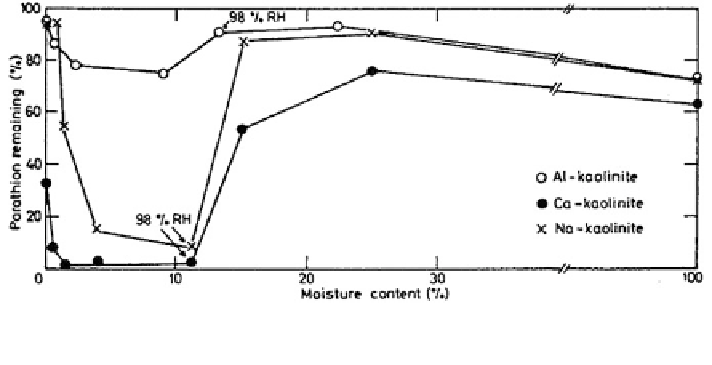Geoscience Reference
In-Depth Information
Fig. 16.15 Parathion degradation on kaolinite as affected by clay water content; incubation
period 15 days (Saltzman et al.
1974
)
slower rate on the direct hydrolysis. Rearrangement and hydrolysis of organo-
phosphates also occurs on smectites and attapulgite clays, their extent being a
function of contaminant structure and of the hydration status of the clays (Yaron
1978
; Yaron and Saltzman
1978
). In the case of pirimiphos ethyl degradation on
Na
+
-smectite, the dominant mode of loss is the direct hydrolysis of the phosphate
ester bond with the pyrimidine ring of the compound. The high rate of hydrolysis
does not enable observation of the rearrangement process. The studies of Saltzman
and Mingelgrin (
1978
) on parathion-smectite and Gerstl and Yaron (
1978
)on
parathion-attapulgite interactions show that these clays act mainly as catalysts for
the rearrangement of parathion molecules. In this case, parathion is rearranged as
an S-ethyl isomer and appears together with hydrolysis. The hydration status of the
clay surface, different for each type of clay and its saturating cation, defines the
type of hydrolysis: directly or through a rearrangement process.
When organic contaminants contact clay layers coated by natural organic
matter, surface interactions between the contaminant and the porous medium
exhibit different patterns. Yaron (
1975
,
1979
) reported abiotic transformation of
organophosphates, in general, and parathion, in particular, in a large number of
soils with various types of clay, amounts of clay, and amounts of organic matter.
Table
16.4
includes data on soil properties and water-soluble parathion degrada-
tion products, formed in sterilized soils after 130 days of incubation at 22 C. The
soils were initially air-dried and subsequently reached wet conditions by adding
distilled water (50 % w/w).
Despite the differences in soil properties, p-nitrophenol was recovered in all the
soils studied, together with water-soluble diethyl-thiphosphate. This result proves
that hydrolysis is the main degradation path, independent of the nature of the soil.
However, both the type of clay and the presence of organic matter affect the
amount of degraded parathion. This behavior is illustrated in Fig.
16.16
.

